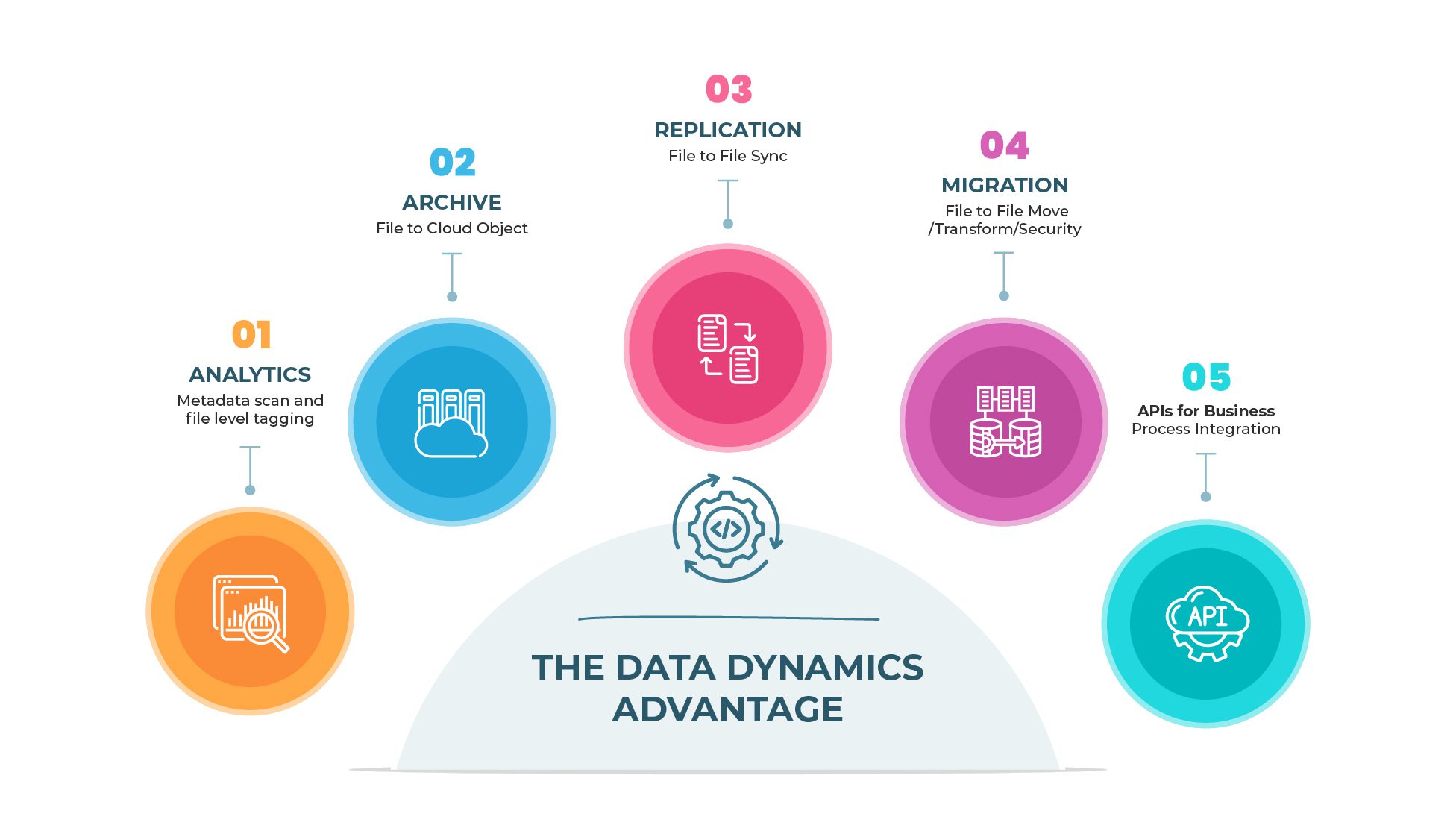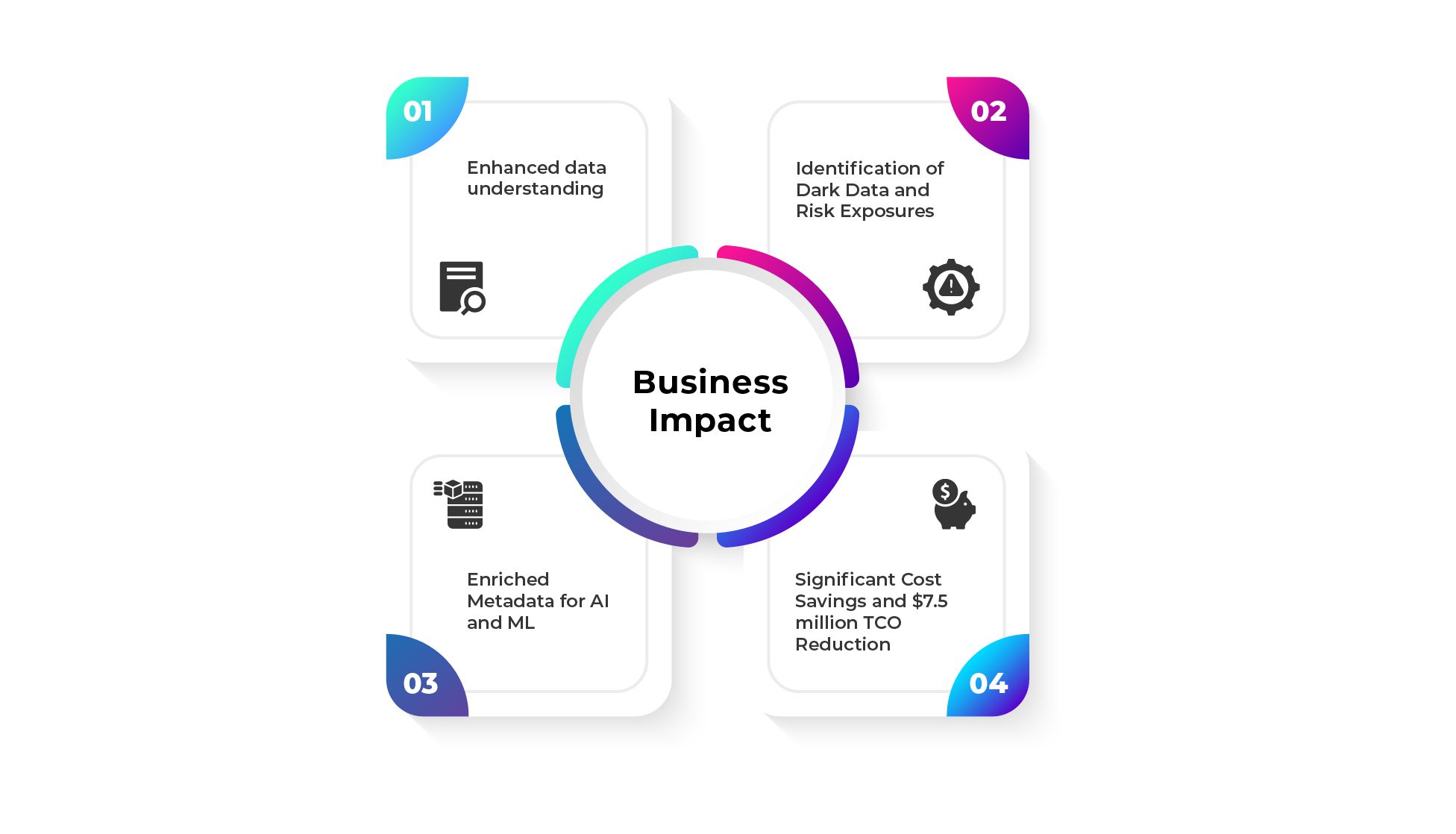The pharmaceutical industry is ruled by data. A vast amount of data is required to complete every step of the process, from clinical trials to regulatory compliance to drug development. In the midst of so much data that is generated every day, valuable insights can quickly get lost in what are referred to as orphan files or dark data. Research reveals that 60 to 85 percent of unstructured data in shared storage setups is dark. For one of the top 5 integrated healthcare services companies worldwide, the challenge of unstructured data growth and dark data posed significant risks and hindered productivity. However, through the implementation of Data Dynamics’ intelligent & unified data management platform, they were able to mitigate these challenges and achieve remarkable results. Let’s delve into their journey and discover how they transformed their data landscape, saving a staggering $7.5 million annually.
About the customer
The customer is one of the world’s top 5 integrated healthcare services companies in the world. The company’s core areas include managed healthcare and wellness, health insurance, pharmacy, and prescription drug coverage.
Understanding the Business Need:
The healthcare industry heavily relies on accurate and accessible data for seamless operations. Our subject company recognized the urgency to implement Data Lifecycle Management (DLM) to address several critical requirements. Firstly, they needed to mitigate risks stemming from data sprawl, ensuring better accessibility, security, and management. Secondly, they aimed to optimize costs by managing dark data, which refers to outdated information, not in use for more than five years. Lastly, optimizing file data storage became essential for streamlining processes.
Challenges Faced: A Daunting Data Landscape
The integrated healthcare services company confronted various formidable challenges that impeded their progress. There was a significant growth and sprawl of unstructured data, which was causing difficulties in effectively managing and organizing the data. This posed both business risks, such as legal and compliance issues, as well as IT risks, including straining production systems, backup systems, and high availability (HA) systems. Legal and compliance issues loomed due to non-critical data being treated as critical, leading to inefficient resource allocation and putting the company in a precarious position. Furthermore, the lack of data understanding and lifecycle management further complicated matters, while dark data plagued their storage infrastructure, with one-third of their storage dedicated to untouched files for five years. Additionally, a shocking four-fifths of their files were orphaned, adding to the complexity.
In a nutshell, the company was looking to:
- Implement Data Lifecycle Management
- Mitigate risk resulting from Data Sprawl
- Understanding the data for better accessibility, security, and management
- Manage dark data for cost optimization
- Optimizing file Data storage
The Data Dynamics Advantage: Intelligent and Unified Data Lifecycle Management
To tackle these challenges head-on, the company implemented Data Dynamics unified data management platform, ushering in a new era of data management. The solution provided a comprehensive range of features, including analytics, archive, replication, migration, and APIs for business process integration using one-single software. Here’s how each element played a pivotal role in transforming their data landscape:


- Analytics – Metadata scan and file level tagging: The implementation of analytics capabilities involved conducting a metadata scan of the company’s data. This process entailed examining the characteristics, properties, and relationships of the files. By analyzing metadata, the company gained valuable insights into their data landscape, including file types, sizes, creation dates, access patterns, and ownership. This comprehensive understanding allowed them to assign appropriate tags to each file, facilitating better organization and management. With file-level tagging, they could categorize data based on its relevance, sensitivity, and retention requirements, streamlining workflows and ensuring compliance with data governance policies.
- Archive – File to Cloud Object: To address the challenge of unstructured data growth and sprawl, the company leveraged file-to-cloud object archiving. This solution involved transferring files from traditional file-based storage systems to cloud-based object storage. By archiving inactive or less frequently accessed files to the cloud, they reduced the strain on their on-premises infrastructure. This approach not only optimized storage resources but also enhanced data accessibility. Users could retrieve archived files from the cloud quickly and seamlessly when needed, ensuring data availability while reducing costs associated with maintaining large on-premises storage systems.
- Replication – File to File Sync: The replication capability offered through intelligent data lifecycle management allowed for real-time synchronization of files across different storage systems. By replicating files from one location to another, the company ensured data availability and resilience. Any changes made to files in the source location were automatically mirrored in the destination, ensuring consistency and reducing the risk of data loss. This solution was particularly valuable in maintaining high availability (HA) systems, as it minimized downtime and improved business continuity.
- Migration – File to File Move/Transform/Security: The policy-based migration feature empowered the company to seamlessly move files from one storage system to another using automation while also providing options for transformation and enhanced security. With this capability, they could transfer files between different storage tiers, optimizing storage utilization. For example, they could move less frequently accessed files to lower-cost storage tiers, freeing up valuable resources in their primary storage. The migration solution allowed for file transformation, enabling format conversions or data restructuring as needed. Furthermore, robust security measures were implemented during migration, ensuring the protection of sensitive data during the transfer process.
- APIs for Business Process Integration: Intelligent data lifecycle management offered APIs (Application Programming Interfaces) that facilitated seamless integration with existing business processes and applications. These APIs allowed the company to connect their data management solution with other software systems, such as enterprise resource planning (ERP) or customer relationship management (CRM) systems. By integrating data management into their existing workflows, they eliminated data silos and improved overall operational efficiency. This cohesive integration ensured that data management became an integral part of their business processes, enabling streamlined workflows and maximizing productivity.
Business Impact: Empowering the Future of Healthcare Data Management
The implementation of intelligent data lifecycle management brought about a seismic shift in the way our subject company managed its data. The results were nothing short of impressive:


- Enhanced data understanding: By leveraging file metadata discovery and classification, the company gained a comprehensive understanding of their data, enabling them to make informed decisions and optimize processes. By assigning tags to files based on their relevance, sensitivity, and retention requirements, they established a systematic approach to data organization. This classification facilitated easier and faster data retrieval, reducing search and access time and ultimately helping to reduce sprawls of unstructured data and gain valuable insights from it in a governed and secure environment. Additionally, the company could enforce data governance policies more effectively, ensuring compliance and reducing the risk of data mishandling.
- Identification of Dark Data and Risk Exposures: Intelligent data lifecycle management enabled the company to identify dark data – older, unused data – and potential risk exposures within their data landscape. By analyzing metadata and access patterns, they could pinpoint files that hadn’t been accessed or modified in over five years. This insight allowed them to assess the value and relevance of dark data and make informed decisions on retention or disposal. By eliminating unnecessary dark data, they reduced storage costs and mitigated potential risks associated with retaining obsolete or sensitive information.
- Enriched Metadata for AI and ML: The comprehensive metadata gathered through intelligent data lifecycle management provided a foundation for advanced technologies like Artificial Intelligence (AI) and Machine Learning (ML). It allowed the company to leverage AI and ML algorithms to gain deeper insights from their data and uncover patterns, correlations, & predictive insights that were previously hidden. This empowered them to make data-driven decisions, improve operational efficiency, and unlock new opportunities for innovation and optimization.
- Significant Cost Savings and $7.5 million TCO Reduction: One of the most significant business values achieved through intelligent data lifecycle management was the substantial cost savings and reduction in Total Cost of Ownership (TCO). By optimizing file data storage, archiving inactive files to the cloud, and eliminating dark data, the company streamlined their storage infrastructure and reduced the need for expensive on-premises storage. This resulted in annual savings of $2 million per petabyte and a remarkable $7.5 million TCO reduction. These cost savings could be redirected towards strategic initiatives, investment in advanced technologies, or other areas that drive business growth
Conclusion: Transforming Data Management in Healthcare with Data Dynamics
Through the implementation of intelligent data lifecycle management, our client revolutionized their data landscape, achieving remarkable savings and transforming their operations. The ability to understand, organize, and optimize data is crucial for businesses across all industries, and healthcare is no exception. By adopting an intelligent and unified approach to managing, optimizing and transforming data, this integrated healthcare services company has set a new standard for data management, positioning themselves as a trailblazer in the industry. As we embrace the future, let us learn from their success and unlock the immense potential of our own data-driven endeavors.
About Data Dynamics
Data Dynamics is a leading provider of enterprise data management solutions, helping organizations structure their unstructured data with their Unified Unstructured Data Management Platform. The platform encompasses four modules- Data Analytics, Mobility, Security, and Compliance. Proven in over 26 Fortune 100 organizations, the Platform uses a blend of automation, AI, ML, and blockchain technologies and scales to meet the requirements of global enterprise workloads. With Data Dynamics, enterprise customers can eliminate the use of individual point solutions with siloed data views. Instead, they can utilize a single software platform to structure their unstructured data, unlock data-driven insights, secure data, ensure compliance and governance and drive cloud data management. Ultimately, the company’s vision is to help enterprises achieve data democratization so that users, no matter their technical background, can instantly access, understand, and derive maximum insights from unstructured data sprawls.
To learn more, please visit – www.datadynamicsinc.com or contact us at solutions@datdyn.com or call us at (713)-491-4298 or +44-(20)-45520800.






